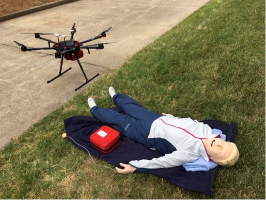Could drones be the key to increasing defibrillator use during a heart attack?
September 16, 2020
When a heart attack happens outside of a hospital, every moment is critical to survival.
Each year, more than 350,000 out-of-hospital cardiac arrests (OHCA) happen in the United States, according to the American Heart Association. An estimated 90% of people who experience one do not survive. If a bystander can respond with cardiopulmonary resuscitation (CPR) and an automated external defibrillator (AED) within the first five minutes, chances of survival can double. While data have shown that few bystanders are able to access or use an AED in a timely manner, new research from UNC-Chapel Hill is aiming to change that.

Dr. Wayne Rosamond
In a study published September 16 in the New England Journal of Medicine, a team led by Wayne Rosamond, PhD, professor of epidemiology at the UNC Gillings School of Global Public Health, tested a new method to give bystanders life-saving access to AEDs: drone delivery. The study monitored the response times of automated drones — dispatched after bystanders called for a drone as part of a simulated OHCA event — and compared those response times to how long it took bystanders to search for an AED in the surrounding area.
“Even though defibrillators may be around in many public spaces, they are rarely used, and many cardiac arrests happen at home where defibrillators are generally not close by. This is where a drone can really make a difference,” Rosamond said. “If we can bring the AED to the scene of a cardiac arrest by a drone faster than an ambulance can reach the scene or faster than a bystander can locate and retrieve an AED, it could save lives.”
Watch a video about Rosamond’s ongoing drone research.
Rosamond and fellow researchers from the Department of Epidemiology — Anna M. Johnson, PhD, and Brittany M. Bogle, PhD — collaborated with faculty at North Carolina State University and the UNC Schools of Medicine and Nursing on a randomized trial of 35 AED drone deliveries conducted around the UNC-Chapel Hill campus. Participants worked in pairs to respond to a simulated OHCA event on a mannequin – one participant made a mock 911 call that deployed a drone carrying an AED, while the other was instructed to find and retrieve an AED stored nearby.
The locations for the OHCA simulations were chosen to duplicate the geographic challenges that a person or drone might encounter when acquiring or delivering an AED, including difficult terrain, limited visibility and business hours that restrict device accessibility.

A drone arrives at the scene of a simulated cardiac arrest.
While delivery times varied depending on the site, the study found that drones delivered an AED within five minutes during 71% of tests, a speed that was matched in only 51% of ground searches performed by a bystander. In all tests, the drone delivered an AED within eight minutes, but the ground search took longer than eight minutes in 26% of tests.
The results also found that the average time from drone launch to landing was similar to the time it took for a bystander to find an AED. Because the drone was able to land consistently within ten feet of the OHCA site, however, the average AED transfer time from the drone to the mannequin was only 22 seconds. By comparison, the bystander took an additional minute, on average, to return to the mannequin after finding an AED.
Rosamond’s study results are a promising indicator that, despite the impact of physical setting, drone delivery of AEDs has the potential to increase timely defibrillator access for sudden cardiac arrest occurring outside a hospital setting. Participants in the trials came away with an overall positive view of drone delivery and a unanimous willingness to utilize the service in the event that they had to respond to a real-life OHCA.
“Based on these promising results, we hope to find ways to integrate drone delivery of AEDs into existing emergency medical services and move this potentially lifesaving application of drone technology into practice,” Rosamond said.
Contact the UNC Gillings School of Global Public Health communications team at sphcomms@unc.edu.
